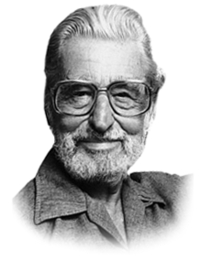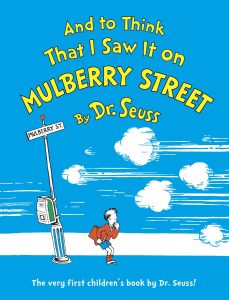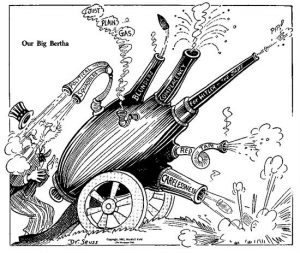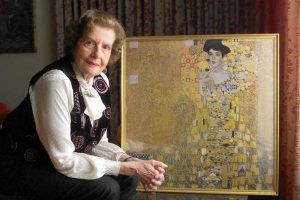
Can we all forget about The Cat in the Hat for a moment? While most of the world associates the brilliance of Dr. Suess with the energy of The Cat in the Hat, that book was a landmark result, not a starting point. The true genesis of Theodor Geisel’s extraordinary career dates back to an earlier moment, with the publication of his first book And to Think That I Saw It on Mulberry Street. The story of this early masterpiece is a crucial, often overlooked narrative that captures the brutal reality of the creative process, a process that nearly ended this beloved author’s career before he even got to begin. Theodore, receiving a long line of rejections, tested both his confidence and creative spirit. Discouraged, he took a walk on the streets of New York, with the crumpled manuscript clenched in his hand, ready to destroy his beautiful work that once filled him with excitement. Yet at that lowest moment, luck or perhaps fate intervened. As he walked, he bumped into a former Dartmouth classmate, who, by coincidence, had just become an editor for children’s books at Vanguard Press. That by-chance encounter not only saved the book from being lost forever but also kicked off the career of one of the country’s most beloved authors. It was this early achievement, combined with the disciplined storytelling Geisel had mastered while creating documentary and propaganda shorts for the U.S. Army during World War II, that created the uniquely structured voice and rhythm that made his later works household staples.

After writing And to Think I Saw It on Mulberry Street on an ocean ship ride, Theodor Geisel returned to New York with an overwhelming hope for his story. It was an imaginative and clever tale that would charm children and adults, so he began submitting his manuscript to publishers. His confidence wasn’t arrogance; it was the conviction of an artist who believed he had captured something genuinely original. He approached the New York publishing houses with optimism, certain that editors would see what he saw. The first rejection letter arrived, and it stung, yet he dismissed it as an easy brush off, still confident in his vision that the next response would be better. That confidence quickly crumbled. Soon after the first rejection came a second rejection, then a third; each refusal was a tiny heartbreak to his growing ambition. Over a period of time that felt like eternity, the rejection letters started to pile up, 27 in total, each one a small reminder that the world didn’t yet understand his playful rhymes and illustrations, dismissed by many editors as “too strange.”1 What had begun as hope slowly turned into frustration. With every rejection Geisel received, his excitement started to fade away, replacing it with doubt and discouragement. That sting became a constant ache of failure. Eventually, he convinced himself that his dream of becoming an author was over. In his mind at that moment, the only logical step he thought was to abandon the entire idea of writing children’s books. So he planned to burn the manuscript out of profound anger.
So, on that cold day in New York, Geisel, weighed down by frustration and disappointment, took a walk through the busy streets. The rejected manuscript that clenched in his hand was no longer beautiful work but a reminder of failure and humiliation. He moved through the busy streets, ready to give up and destroy the manuscript that had once given him hope. It was at that lowest moment, as he walked the city streets, that he suddenly bumped into that old college friend. This meeting was more than a casual reunion; it was the moment fate intervened and became the turning point in Geisel’s life. This friend had recently become a new editor in the children’s section at Vanguard Press.2 His friend listened to Geisel pour out his frustration and learned of his plan to destroy the manuscript. The editor, curious about the whimsical writing style that had drawn mixed reactions, offered to take a look at it. In that moment, the path of Dr. Seuss’s entire career changed. Geisel himself later reflected on the moment with clarity that if he had been walking down the opposite side of the street, he probably never would have become the children’s author we’ve grown to love and know.3 Twenty-seven publishers had rejected him, yet the twenty-eighth opportunity was delivered not by effort but by a simple random encounter on the streets.

After enduring 27 rejections, Geisel’s book And to Think That I Saw It on Mulberry Street was finally accepted by that single editor and published in 1937. For Geisel, this moment was a relief and a long-awaited breakthrough with children’s literature. The book’s rhythmic and imaginative story captured readers’ attention and received many great reviews, and became a success, finally launching Theodor Geisel’s long-sought-after career.4 This early publishing triumph brought back Geisel’s confidence. He then continued to experiment with rhyme, wordplay, and his illustration techniques, which later defined his signature style. However, in the following years, that foundation of creativity was combined with the discipline and storytelling lessons he would later learn while creating war films for the army, which refined his creative process.5 These experiences together had shaped him to become the beloved and amazingly well-known author Dr. Seuss, whose work continues to inspire generations of young readers.
- How Dr. Seuss Got His Start ‘On Mulberry Street’,” Morning Edition, January 24, 2012. ↵
- Ruth K. MacDonald, Dr. Seuss (Boston: Twayne Publishers, 1988), 7. ↵
- “How Dr. Seuss Got His Start ‘On Mulberry Street’,” Morning Edition, January 24, 2012. ↵
- Christopher S. W. Koehler, “Dr. Seuss,” Salem Press Biographical Encyclopedia (April 2023). ↵
- Montgomery McFate, “Dr. Seuss and the Art of War: Secret Military Lessons,” Parameters (Summer 2025), 2-3. ↵




9 comments
Enrique Maciel
This was interesting and know knowledgeable I’ve always known of Dr Seuss by my childhood growing up not much about his background of who he really was above all good or bad the stories interesting the books he’s wrote awesome thank you for that
MaryHelen Garcia
This article is very informative. No one would have ever guessed that he made war movies in his early days. This article is well written.
Gabby Garcia
This was such an inspiring and beautifully written piece! I really enjoyed learning about Dr. Seuss’s early struggles and how his perseverance led to success. The way you told his story was so heartfelt and engaging—it made his journey feel real and motivating. I never knew this part of his life, and your writing brought it to life in such a meaningful way. Great job capturing both the emotion and inspiration behind his story!
Ashley cano
Amazing job !!!!very educational and learned more about the author keep up the good work and good luck.
Brandy Garcia
WOW . 🤯
I wouldn’t have known half of the back story of our child hood book / Arthur . Reading so much about it is crazy . To the writer who wrote this , Keep up the amazing work and writings .
Jose castellano
I never new that about Dr.Seuss what an amazing article can’t wait to read more articles you publish
John Lucio
This article was very informative. There was lot I learned about the artist dr. Seuss just by reading the article.
Keep up the good work….
Caroline Luna
Amazing job Alexis. So proud of you for writing and publishing this !
Rey
Great story never knew that about this guy